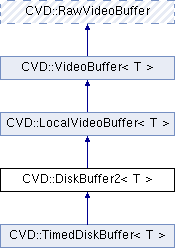Play a series of image files as a video stream. More...
#include <diskbuffer2.h>

Public Member Functions | |
| DiskBuffer2 (const std::vector< std::string > &names, double fps, VideoBufferFlags::OnEndOfBuffer eob=VideoBufferFlags::RepeatLastFrame) | |
| virtual ImageRef | size () |
| virtual bool | frame_pending () |
| virtual DiskBuffer2Frame< T > * | get_frame () |
| virtual void | put_frame (VideoFrame< T > *f) |
| virtual void | seek_to (double t) |
| virtual void | on_end_of_buffer (VideoBufferFlags::OnEndOfBuffer eob) |
| virtual double | frame_rate () |
Protected Attributes | |
| ImageRef | my_size |
| int | next_frame |
| double | start_time |
| double | time_per_frame |
| double | frames_per_sec |
| bool | frame_ready |
| std::vector< std::string > | file_names |
| VideoBufferFlags::OnEndOfBuffer | end_of_buffer_behaviour |
Related Functions | |
(Note that these are not member functions.) | |
| std::vector< std::string > | globlist (const std::string &gl) |
Detailed Description
template<typename T>
class CVD::DiskBuffer2< T >
Play a series of image files as a video stream.
Provides frames of type CVD::DiskBuffer2Frame and throws exceptions of type CVD::Exceptions::DiskBuffer2
- Parameters:
-
T The pixel type of the frames to provide (usually CVD::Rgb<CVD::byte>orCVD::byte. If the image files are of a different type, they will be automatically converted (see Image loading and saving, and format conversion).
Definition at line 91 of file diskbuffer2.h.
Constructor & Destructor Documentation
| CVD::DiskBuffer2< T >::DiskBuffer2 | ( | const std::vector< std::string > & | names, |
| double | fps, | ||
| VideoBufferFlags::OnEndOfBuffer | eob = VideoBufferFlags::RepeatLastFrame |
||
| ) | [inline] |
Construct a DiskBuffer2 from a vector of filenames.
Typically the globlist() helper function is used to provide the filenames e.g. DiskBuffer2 buffer(globlist("~/Images/lab*.jpg"), 25);
- Parameters:
-
names The filenames to use (played in the order that they are in the vector) fps The frames per second to report for this VideoBuffer eob What should the buffer do when it reaches the end of the list of files?
Definition at line 137 of file diskbuffer2.h.
References CVD::img_load(), and CVD::SubImage< T >::size().
Member Function Documentation
| void CVD::DiskBuffer2< T >::put_frame | ( | VideoFrame< T > * | f | ) | [inline, virtual] |
Tell the buffer that you are finished with this frame.
Typically the VideoBuffer then destroys the frame.
- Parameters:
-
f The frame that you are finished with.
Implements CVD::LocalVideoBuffer< T >.
Definition at line 227 of file diskbuffer2.h.
| void CVD::DiskBuffer2< T >::seek_to | ( | double | ) | [inline, virtual] |
Go to a particular point in the video buffer (only implemented in buffers of recorded video)
- Parameters:
-
t The frame time in seconds
Reimplemented from CVD::LocalVideoBuffer< T >.
Definition at line 242 of file diskbuffer2.h.
| virtual void CVD::DiskBuffer2< T >::on_end_of_buffer | ( | VideoBufferFlags::OnEndOfBuffer | eob | ) | [inline, virtual] |
What should the buffer do when it reaches the end of the list of files?
- Parameters:
-
eob The desired behaviour
Definition at line 115 of file diskbuffer2.h.
Friends And Related Function Documentation
| std::vector< std::string > globlist | ( | const std::string & | gl | ) | [related] |
Make a list of strings from a UNIX-style pattern pathname expansion.
Tilde expansion is done, and * ? [] and {} can all be used as normal. The filenames are returned in alphabetical (and numerical) order.
- Parameters:
-
gl The pattern from which to generate the strings
The documentation for this class was generated from the following file:
- cvd/diskbuffer2.h
 1.7.4
1.7.4